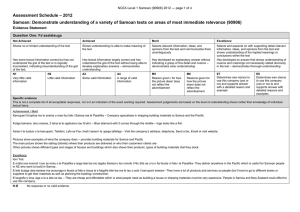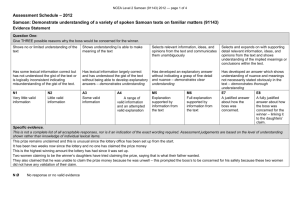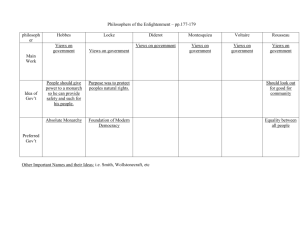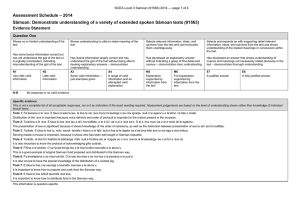– 2011 Assessment Schedule
advertisement
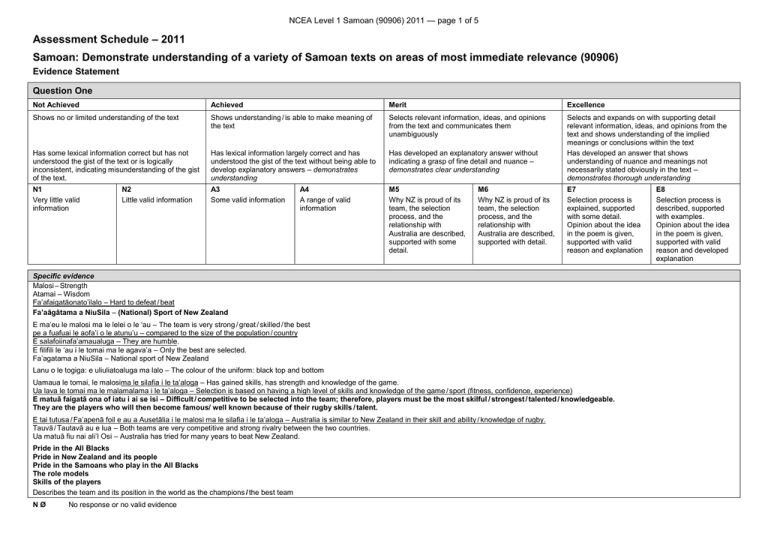
NCEA Level 1 Samoan (90906) 2011 — page 1 of 5 Assessment Schedule – 2011 Samoan: Demonstrate understanding of a variety of Samoan texts on areas of most immediate relevance (90906) Evidence Statement Question One Not Achieved Achieved Merit Excellence Shows no or limited understanding of the text Shows understanding / is able to make meaning of the text Selects relevant information, ideas, and opinions from the text and communicates them unambiguously Has some lexical information correct but has not understood the gist of the text or is logically inconsistent, indicating misunderstanding of the gist of the text. Has lexical information largely correct and has understood the gist of the text without being able to develop explanatory answers – demonstrates understanding Has developed an explanatory answer without indicating a grasp of fine detail and nuance – demonstrates clear understanding Selects and expands on with supporting detail relevant information, ideas, and opinions from the text and shows understanding of the implied meanings or conclusions within the text Has developed an answer that shows understanding of nuance and meanings not necessarily stated obviously in the text – demonstrates thorough understanding N1 Very little valid information A3 Some valid information M5 Why NZ is proud of its team, the selection process, and the relationship with Australia are described, supported with some detail. N2 Little valid information A4 A range of valid information M6 Why NZ is proud of its team, the selection process, and the relationship with Australia are described, supported with detail. E7 Selection process is explained, supported with some detail. Opinion about the idea in the poem is given, supported with valid reason and explanation Specific evidence Malosi – Strength Atamai – Wisdom Fa’afaigatāonato’ilalo – Hard to defeat / beat Fa’aāgātama a NiuSila – (National) Sport of New Zealand E ma’eu le malosi ma le lelei o le ‘au – The team is very strong / great / skilled / the best pe a fuafuai le aofa’i o le atunu’u – compared to the size of the population / country E salafoiinafa’amaualuga – They are humble. E filifili le ‘au i le tomai ma le agava’a – Only the best are selected. Fa’agatama a NiuSila – National sport of New Zealand Lanu o le togiga: e uliuliatoaluga ma lalo – The colour of the uniform: black top and bottom Uamaua le tomai, le malosima le silafia i le ta’aloga – Has gained skills, has strength and knowledge of the game. Ua lava le tomai ma le malamalama i le ta’aloga – Selection is based on having a high level of skills and knowledge of the game / sport (fitness, confidence, experience) E matuā faigatā ona of iatu i ai se isi – Difficult / competitive to be selected into the team; therefore, players must be the most skilful / strongest / talented / knowledgeable. They are the players who will then become famous/ well known because of their rugby skills / talent. E tai tutusa / Fa’apenā foil e au a Ausetālia i le malosi ma le silafia i le ta’aloga – Australia is similar to New Zealand in their skill and ability / knowledge of rugby. Tauvā / Tautavā au e lua – Both teams are very competitive and strong rivalry between the two countries. Ua matuā fiu nai ali’I Osi – Australia has tried for many years to beat New Zealand. Pride in the All Blacks Pride in New Zealand and its people Pride in the Samoans who play in the All Blacks The role models Skills of the players Describes the team and its position in the world as the champions / the best team NØ No response or no valid evidence E8 Selection process is described, supported with examples. Opinion about the idea in the poem is given, supported with valid reason and developed explanation NCEA Level 1 Samoan (90906) 2011 — page 2 of 5 Question Two Not Achieved Achieved Merit Excellence Shows no or limited understanding of the text Shows understanding / is able to make meaning of the text Selects relevant information, ideas, and opinions from the text and communicates them unambiguously Has some lexical information correct but has not understood the gist of the text or is logically inconsistent, indicating misunderstanding of the gist of the text. Has lexical information largely correct and has understood the gist of the text without being able to develop explanatory answers – demonstrates understanding Has developed an explanatory answer without indicating a grasp of fine detail and nuance – demonstrates clear understanding Selects and expands on with supporting detail relevant information, ideas, and opinions from the text and shows understanding of the implied meanings or conclusions within the text Has developed an answer that shows understanding of nuance and meanings not necessarily stated obviously in the text – demonstrates thorough understanding N1 Very little valid information A3 Some valid information M5 Describes and explains what is happening in both photos, supported with some detail. N2 Little valid information A4 A range of valid information M6 Describes and explains what is happening in both photos, supported with valid reason. E7 Explains how Samoan culture is reflected in both photos E8 Explains fully how Samoan culture is reflected in both photos Specific evidence Tamaitilāiti o le a sauni e fa’afiafia – Young children preparing for a performance E foliga pei e popole ma mafaufau I latou taga ma faafiafiaga – Except the boys are smiling wanting to go and perform now E foligamai o se aso fa’apitoa, atonu o se fa’afiafiaga mo se a’oga po o se aulotu / poo se tauvaga – Possibly / it seems like they are performing for a special occasion / school / church / or getting ready to compete in a cultural performance competition. Tutū i le laina e sauni e o e faafiafia – They are standing in a line waiting to go on and perform. O loo o’ofu i le togiga – They are wearing traditional costumes. O le ata o teineiti o lo o matamata i se fa’afiafiaga – Girls watching a performance E foliga fiafia ina ua uma le latou faafiafiaga – Smiles because they have already performed E foliga mai ua uma lo latou fa’afiafiaga pe o lo o fa’atali lo latou fa’afiafiaga auā o lo o nonofo i lalo i luma o le malae o fa’afiafiaga. – They seem to be either waiting for their performance, or have finished performing. O se fa’atasiga o lo o fa’ailogaina ai fa’afiafiagaf a’aleaganu’u auā o lo o fai o latou mitiafu ma sulu o latou ie lavalava. – The gathering seems to be cultural performances because the girls are wearing T-shirts and ie lavalava. O lo o fefiloi teineiti, atonu ose a’oga o lo o fa’afiafia – It looks like a school cultural festival because the girls look like they are from different ethnic backgrounds. Teuga fa’asamoa – Traditional Samoan costumes and accessories -puletasi, ie lavalava, seifulumoa, ula, tusi alāfau, fa’asausau tama Fa’afiafiaga Samoa e fa’aaogā ai siva ma pese / fa’afiafiaga fa’asamoa – Samoan performances would include Samoan dances, music, songs. O a latou fa’afiafiaga o le a fa’aaogāinafoi le gagana Samoa – Through their performances they would use Samoan language. E fa’aalia ai le mitamitaga o tamaiti i nei tu ma agafa’asamoa – This also shows / reflects their pride in and use of Samoan customs and culture. The girls are dressed in ie lavalava to perform a cultural item. Their pride of sharing the Samoan culture and language is shown through the mixed ethnicities of the girls, who look like they are enjoying the experience of performing and watching cultural performances. Teuga o lo o ofuina – Costumes and accessories Tausaga o tamaiti – Ages of the children Ituaiga au fa’afiafia (fefiloi / na o teine) – Types of groups (boys and girls / girls only / mixed ethnicities) Ata A: Sauni e fa’afiafia – Standing in lines, not sitting down togiga / puletasi, teuga Ata B: Uma ona fa’afiafia – Sitting down, ie lavalava ma mitiafu Ata A: Foliga vaaia, o loo vaaia le popole ma le tau matau / mafaufau o latou faafiafiaga Ata B: Foliga fiafia, ua mae’a latou faafiafiaga, foliga fiafia ona o loo matamata I isi faafiafiaga NØ No response or no valid evidence NCEA Level 1 Samoan (90906) 2011 — page 3 of 5 Question Three Not Achieved Achieved Merit Excellence Shows no or limited understanding of the text Shows understanding / is able to make meaning of the text Selects relevant information, ideas, and opinions from the text and communicates them unambiguously Has some lexical information correct but has not understood the gist of the text or is logically inconsistent, indicating misunderstanding of the gist of the text. Has lexical information largely correct and has understood the gist of the text without being able to develop explanatory answers – demonstrates understanding Has developed an explanatory answer without indicating a grasp of fine detail and nuance – demonstrates clear understanding Selects and expands on with supporting detail relevant information, ideas, and opinions from the text and shows understanding of the implied meanings or conclusions within the text Has developed an answer that shows understanding of nuance and meanings not necessarily stated obviously in the text – demonstrates thorough understanding N1 Very little valid information A3 Some valid information M5 A wide range of valid information including where to buy food. An opinion about walking to school given, supported with a reason N2 Little valid information Specific evidence Kowhai Road Fa’afesāga’i ma le malae netipolo I le va o Tuigamala Drive ma Mene Lane Autafa o le – Roundabout A4 A range of valid information NOTHING BOLDED? Mauga Wikitoria – Mt. Wikitoria Ofisa Fuimū – Fire station Auala laupapa – Bridge Malae lakapī – Rugby field Malae netipolo – Netball field Falesā – Church Malae soka – Soccer field Taulaga – Township / Shopping centre FaleFa’amalositino – Gym Eroni Street Michael Jones Close Tuigamala Drive Mene Lane Adams Avenue Kowhai Road Fale’oloa, Falefalaoa, Pamupenisini – Shop / dairy, bakery, petrol station, Falea’oga – school Malae netipolo, malae soka, malae lakapī Fa’afesāga’i ma lo’u aiga – Opposite my house Kowhai Road Michael Jones Close Ioe: Latalata I lo’u fale Oute savali sa’o i le auala o Kowhai, e lēafe, pe ui ane i se isi auala Manaia mata’aga e mafa iona ou matamata ai. E mafia ona fa’atau la’u meaai pe a ou savali I le a’oga E mafia ona sefe le tupe pe a ou savali Leai: E umī le auala o Kowhai E foligamai e pisi le auala NØ No response or no valid evidence M6 A wide range of valid information including where to buy food. An opinion about walking to school given, supported with reasons E7 A wide range of valid information. An opinion about walking to school given, supported with explanations E8 A wide range of valid information. An opinion about walking to school given, supported with detailed explanations NCEA Level 1 Samoan (90906) 2011 — page 4 of 5 Question Four Not Achieved Achieved Merit Excellence Shows no or limited understanding of the text Shows understanding / is able to make meaning of the text Selects relevant information, ideas, and opinions from the text and communicates them unambiguously Has some lexical information correct but has not understood the gist of the text or is logically inconsistent, indicating misunderstanding of the gist of the text. Has lexical information largely correct and has understood the gist of the text without being able to develop explanatory answers – demonstrates understanding Has developed an explanatory answer without indicating a grasp of fine detail and nuance – demonstrates clear understanding Selects and expands on with supporting detail relevant information, ideas, and opinions from the text and shows understanding of the implied meanings or conclusions within the text Has developed an answer that shows understanding of nuance and meanings not necessarily stated obviously in the text – demonstrates thorough understanding N1 Very little valid information A3 Some valid information across a several parts of the question M5 Briefly / partly explains why people are happy to live in NZ, like the name Aotearoa, and support outrigging. Gives some information about why Pacific people are called navigators. N2 Little valid information A4 A range of valid information about New Zealand, different peoples, the name Aotearoa, outrigging and navigation. M6 Explains why people are happy to live in NZ, like the name Aotearoa, and support outrigging. Gives some valid information about why Pacific people are called navigators. E7 Explains why people are happy to live in NZ, like the name Aotearoa, and support outrigging. Gives an opinion about why Pacific people are called navigators, with reason and detailed explanation. E8 Explains why people are happy to live in NZ, like the name Aotearoa, and support outrigging. Gives an opinion about why Pacific people are called navigators with valid reason and developed explanation. Specific evidence Manaia tele ona laufanua – Beautiful landscape Si’omia e le sami lanumoana – Surrounded by blue sea / ocean E lē a’afia i matagi malolosi – Not affected by strong winds such as cyclones, tornados, hurricanes E olafiafia ona tagata – People live happily Māori Papālagi – Europeans Tagata Asia – Asians Melenesia – Melanesians Pasefika – Pacific O le upu Māori: Māori word – Native language of New Zealand E fiafia tagata i le uiga o le upu: O se aoumi pa’epa’e – People like the meaning of the word: the long white cloud. Ioe: O le gagana o le atunu’u o NiuSila, e tatau ona fa’aaogāina – Native language of New Zealand O le igoa e patino tonu iā NiuSila – This name is unique to New Zealand because it describes what it looks like. O le ulua’iigoa o NiuSila, ae le’I nofoia e Papalagi. – It was the first / initial name before Europeans arrived. E fa’apea fo’i lo tatou naunau e fa’aaogā le igoa a le atunu’u pe anafa’apea o Samoa. – We would feel strongly about using the original name if it was Samoa. O tino o tagataPasefika, o tino o tagataalova’a, malolosi o latou lima i le aloina o le foe – Pacific people have suitable physique for outrigging; they have strong arms for rowing. Masani i le aloina o va’a – Skilled / experienced sailors as we know through the history of the Pacific how Pacific people navigated and sailed the Pacific Ocean E tatau ona filifili atagata ona e agava’amo le alova’aaelēfa’apeana o tagata Pasefika. Ioe, Auā o tagata Polenisia o tagatafolau, e masani e alopaopao e fāgogota I le sami, fa’apeafo’i le folau ma malaga I atumotuuma o le Pasefika. O tagatafoi e atamamai ma agava’a i le folau i le sami. Latou te lē tau fa’aaogāina ni tapasā aefa’amoemoe i le tau / matagi ma fetū auā lo latou femalagaa’i. Atonu o le mafua’aga lea namaloa i NiuSila i le Ipua Amerika. Because Polynesians are sailors who are used to canoeing and sailing in order to fish as well as travel to other islands of the Pacific. Polynesians are known for their navigational skills. They did not use compasses but relied on the wind / seasons / and stars to guide them. This could explain why New Zealand won the America’s Cup. NØ No response or no valid evidence NCEA Level 1 Samoan (90906) 2011 — page 5 of 5 Judgement Statement Score range Not Achieved Achievement Achievement with Merit Achievement with Excellence 0 – 10 11 – 18 19 – 24 25 – 32
